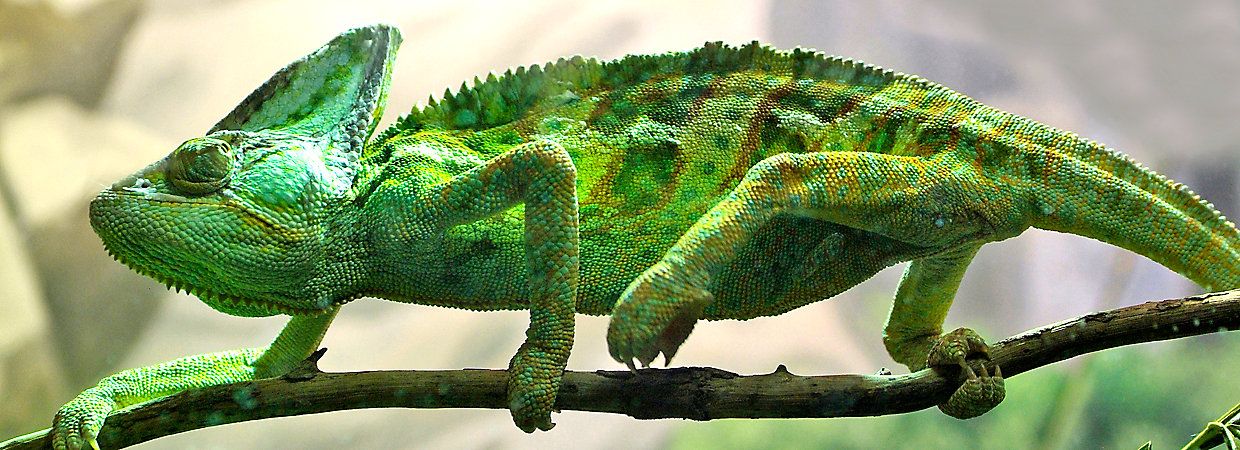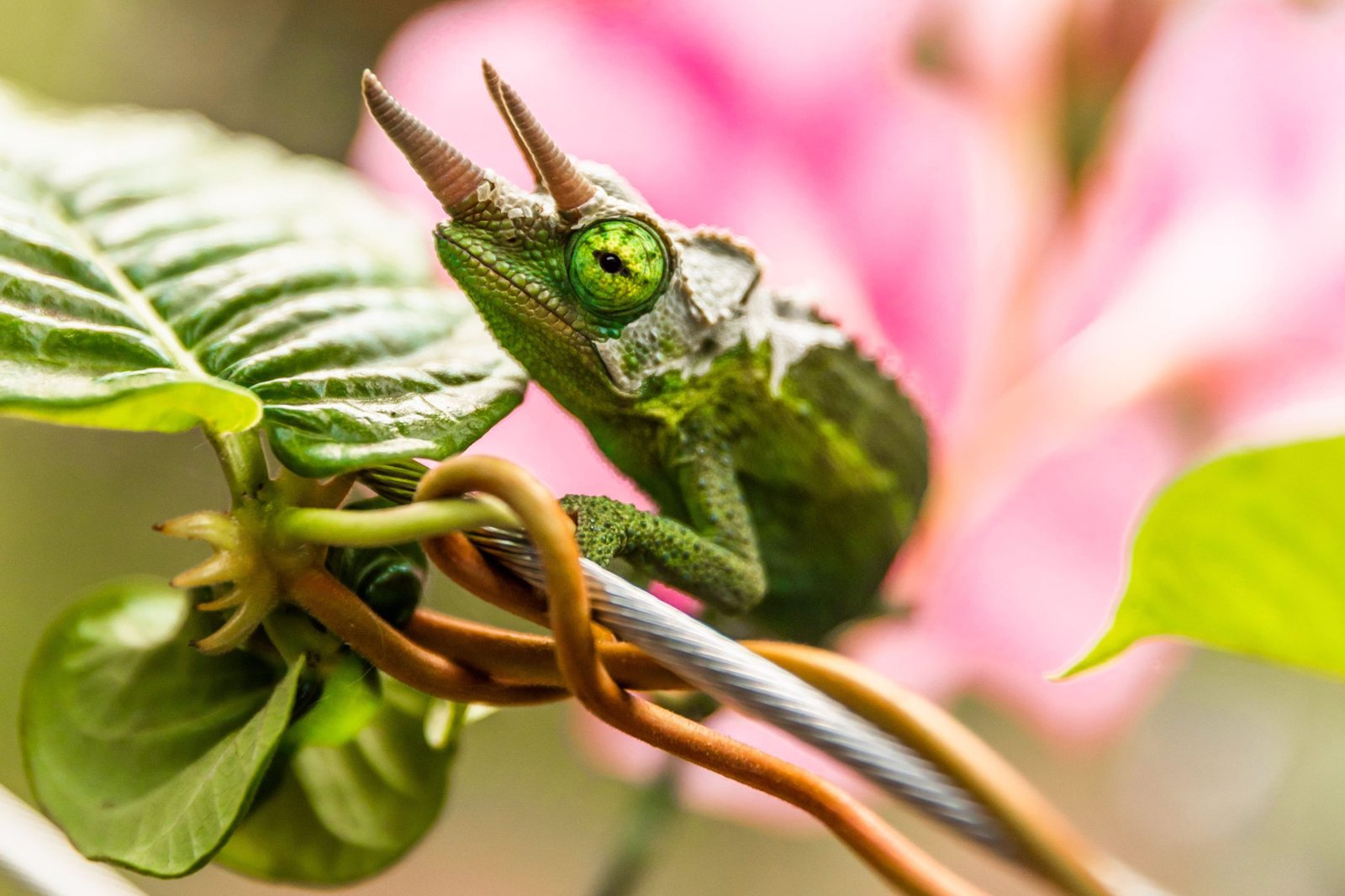Caring for pet chameleons requires careful attention to enclosure setup, specific lighting and heating requirements, humidity control, proper feeding, and understanding their unique behaviors and health considerations. Chameleons are not recommended as pets for beginners or inexperienced reptile owners due to their high-maintenance nature and specific care needs.
It is important to create a suitable, solitary environment for chameleons and provide them with a diet consisting of live insects. It is also crucial to monitor their health, ensure proper hydration, and be aware of potential health issues. Overall, pet chameleons require dedicated care and attention to thrive and should be considered by experienced reptile keepers.

Understanding Chameleons As Pets
Understanding chameleons as pets includes caring for them properly. From providing the right enclosure to ensuring optimal humidity levels and feeding them a nutritious diet, taking care of pet chameleons can be a rewarding but challenging experience.
Are chameleons good pets?
When it comes to choosing a pet, chameleons are a unique and fascinating option. They are known for their ability to change colors and their distinctive appearance, which makes them a captivating addition to any home. While chameleons require specific care and attention, they can be rewarding and enjoyable pets for the right owner.
How long do chameleons live?
Chameleons have the potential to live for several years if they are provided with the proper care and environment. On average, they typically live between 5 and 10 years, although some individuals have been known to live even longer with the right care.
What Do Chameleons Eat, and How Often Do They Need to Be Fed?
Chameleons have unique dietary needs and require a varied and balanced diet to thrive. Their diet primarily consists of insects such as crickets, mealworms, and locusts. It’s important to gut-load the insects before feeding them to your chameleon to ensure they receive proper nutrition.
Adult chameleons are usually fed every other day, while juveniles may require daily feedings. It’s essential to provide fresh water for your chameleon at all times, and consider using a drip system or misting to provide hydration.
What Kind of Enclosure Do Chameleons Need?
Chameleons need a spacious and well-ventilated enclosure to mimic their natural habitat. The enclosure should have adequate ventilation to maintain proper airflow and prevent respiratory issues. A reptile-specific terrarium with mesh sides is typically recommended.
Inside the enclosure, it’s important to provide branches and foliage to create climbing opportunities and hiding places for your chameleon. Live or artificial plants can be used to create a natural environment and provide cover for your pet.
Can chameleons change colors?
Yes, one of the most fascinating aspects of chameleons is their ability to change colors. They use this feature for communication, thermoregulation, and camouflage. However, it is important to note that not all chameleons can change colors to the same extent. Species such as panther chameleons are known for their vibrant color-changing abilities, while others may have more limited color ranges.
Do chameleons like to be handled?
Chameleons are generally not considered to be a “hands-on” or cuddly pet. They are solitary creatures that prefer to have their own space and may become stressed or agitated if handled too frequently or roughly. It is best to limit handling and focus on providing them with a suitable and enriching environment.
How do chameleons reproduce?
Chameleons have unique reproductive behaviors. Males and females will engage in courtship rituals, including elaborate displays and color changes. The female will lay eggs, which are typically buried in soil or substrate. Incubation times vary depending on the species and environmental conditions.
Do chameleons bite?
While chameleons are generally not aggressive towards humans, they can bite if they feel threatened or stressed. However, their bites are typically not dangerous or harmful to humans. It’s important to handle them with care and respect their boundaries to avoid any potential issues.
Caring For Pet Chameleons
Before you bring home a pet chameleon, it’s essential to choose the right species that fits your lifestyle and experience level. Some popular pet chameleon species include the Veiled Chameleon, Panther Chameleon, Jackson’s Chameleon, and Flap-necked Chameleon.
To ensure your pet chameleon thrives, it’s crucial to create a proper habitat that mimics their natural environment. A spacious and well-ventilated chameleon terrarium, such as the Zoo Med ReptiBreeze Chameleon or Exo Terra Rainforest Habitat Kit, is recommended. Make sure it provides enough vertical space for climbing and plenty of branches and vegetation for hiding and basking.
Proper lighting is essential for the health of your pet chameleon. They require both UVB lighting to metabolize calcium and artificial plant LED lights to simulate their natural habitat. Make sure to use high-quality heat and UVB bulbs suitable for reptiles, such as the Zoo Med Deluxe ReptiBreeze or Zilla Desert Reptile Terrarium Screen.
When it comes to feeding your pet chameleon, a well-balanced diet is crucial. They primarily feed on live insects, such as crickets, mealworms, domestic silk moths, locusts, and cockroaches. It’s important to gut-load these insects with nutrient-rich foods and provide proper supplementation, such as calcium and vitamin D3, to ensure optimal nutrition.
Chameleons require a specific level of humidity for proper hydration and shedding. Maintaining optimal humidity levels in their habitat is vital. Regular misting using a fine mist sprayer can help simulate their natural environment and keep the humidity consistent. You can also use foggers and drippers for added moisture, especially during shedding.
Like any other pet, chameleons are susceptible to certain health issues. It’s essential to monitor their overall health and behavior closely. Some common health issues in chameleons include respiratory infections, metabolic bone disease, dehydration, and parasites. If you notice any symptoms or unusual behavior, it’s recommended to consult a reptile veterinarian promptly.
Challenges And Considerations
Caring for pet chameleons comes with its own set of challenges and considerations. From providing the right enclosure and lighting to maintaining humidity levels and properly feeding them, it is important to ensure their well-being and create a suitable environment for them to thrive.
Level Of Difficulty In Care
When it comes to caring for pet chameleons, it’s important to understand that they require a high level of care and attention. Chameleons have specific needs in terms of their environment, feeding, and health. This can make them quite challenging to care for, especially for beginners or inexperienced reptile owners.
Suitability For Beginners
Caring for a chameleon is not recommended for beginners in the reptile-keeping hobby. Their intricate needs and sensitivity to changes in the environment make them more suitable for owners with prior experience in reptile care. If you are a beginner, it is advisable to start with a more beginner-friendly reptile species before considering a chameleon.
Recommended Chameleon Species For Beginners
- Veiled Chameleon: Veiled chameleons are known for their hardiness and adaptability. They are more forgiving of beginners’ mistakes compared to other chameleon species.
- Panther Chameleon: Panther chameleons are another popular choice for beginners. They are relatively hardy and can tolerate a wider range of environmental conditions.
- Jackson’s Chameleon: Jackson’s chameleons are known for their calm and docile nature, making them easier to handle for beginners.
- Flap-necked Chameleon: Flap-necked chameleons are also considered suitable for beginners due to their hardiness and ability to adapt to a variety of environments.
Essential Chameleon Supplies
Properly setting up a chameleon habitat is crucial for their well-being. Here are some essential supplies you’ll need:
| Chameleon Setup | Recommended Products |
|---|---|
| Chameleon Enclosure | Zoo Med ReptiBreeze Chameleon Terrarium |
| Chameleon Terrarium Accessories | New Age Pet Mojave Reptile Lounger, Exo Terra Rainforest Habitat Kit |
| Chameleon Lighting | Zoo Med Deluxe ReptiBreeze Lighting Kit, Exo Terra Screen Terrarium |
In addition to the setup, it’s important to ensure a suitable diet for your chameleon. Some commonly recommended chameleon food options include crickets, mealworms, domestic silk moths, locusts, and cockroaches.
Overall, caring for pet chameleons can be a rewarding experience, but it comes with its own set of challenges and considerations. It is essential to thoroughly research these unique reptiles and their requirements before deciding to bring one into your home. With the right knowledge and preparation, you can provide a healthy and thriving environment for your pet chameleon.
:strip_icc()/chameleons-t2-1236756-7c0990b9001c4cf1a4b064ad4cc556f1.png)

Frequently Asked Questions Of Caring For Pet Chameleons
Are Chameleons Easy To Take Care Of?
Chameleons are not easy to take care of and are not recommended for inexperienced reptile owners. They require specific environmental conditions and can be high-maintenance pets. Additionally, chameleons are solitary animals and should not be kept with other pets.
Are Pet Chameleons High Maintenance?
Pet chameleons are high maintenance and not suitable for first-time reptile owners. They require specific enclosures, heat and UVB bulbs, humidity control, regular misting, and proper feeding with gutloading and supplements. Chameleons also need solitude and should not be kept with other pets.
Are Chameleons Good Pets For Beginners?
Chameleons are not recommended as pets for beginners. They are challenging to care for and require specific habitat needs. Additionally, chameleons are solitary animals and may not do well with other pets.
What Do I Need To Get A Chameleon?
To get a chameleon, you will need the following: a suitable enclosure, heat and UVB bulbs, plant LED lights, proper humidity levels, misting equipment, branches and decor for the enclosure, live plants, appropriate food and gut-loading supplies, supplements, and knowledge of health issues, gender identification, and egg laying.
It’s important to understand that chameleons are high-maintenance pets and may not be suitable for beginners.
Conclusion
Caring for pet chameleons can be a rewarding experience for those looking for a unique and exotic companion. However, it’s important to note that chameleons require specialized care and attention. From providing the right enclosure and lighting to ensuring proper humidity levels, there are many factors to consider when caring for these fascinating creatures.
By following the guidelines outlined in this guide, you can create a healthy and happy environment for your pet chameleon. Remember, while chameleons may not be suitable for first-time reptile owners, with proper knowledge and dedication, they can make wonderful pets.

